10 Tips From Bartenders For Making The Best Palomas
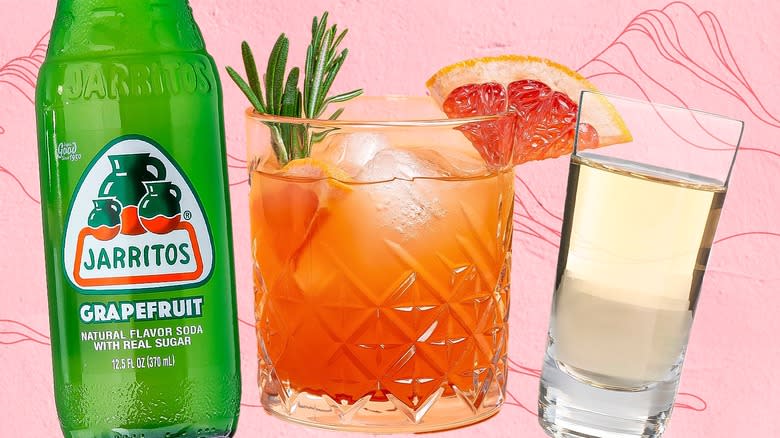
When it comes to warm weather sipping, it's good to have a few easy-to-make cocktails up your sleeve. We'd never say no to an Aperol spritz or a minty mojito, of course, but if you're looking for something else to add to your repertoire? Don't sleep on the paloma.
A paloma is light, refreshing, and incredibly simple to mix. At its most basic, the highball cocktail pairs tequila with grapefruit soda -- and that's it. In fact, while the history of the paloma is a little unclear, it's definitely tied to the invention of Squirt grapefruit soda in Arizona in 1938.
Now, simplicity may make this mixed drink a beloved summer sipper. But many bartenders have gotten creative with their paloma preparations over the years. To learn more about the best ways to upgrade this tart and tasty classic, we spoke to three different bartenders to get their take: Eric Garcia, lead bartender at Toro in Denver; Adolfo Valdez, bar manager at Guerrilla Tacos in Los Angeles; and Matthew Belanger of Death & Co. Here are 10 exclusive tips from professional bartenders to help you make the best palomas at home.
Read more: The 40 Absolute Best Cocktails That Feature Only 2 Ingredients
Choose The Right Tequila
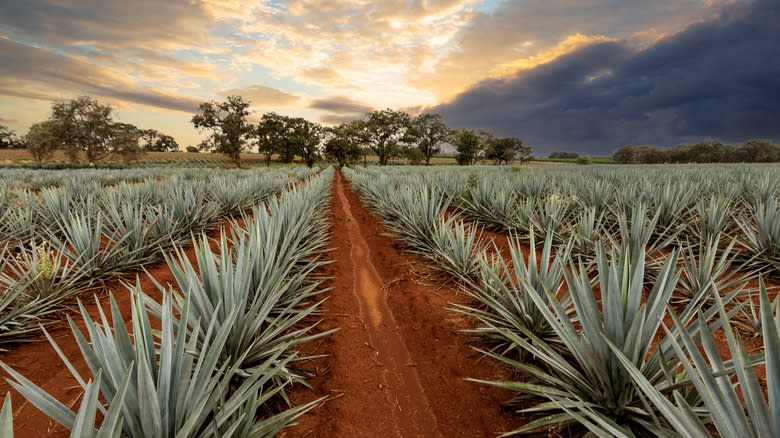
Grapefruit might be the starring flavor in a paloma, but it's tequila that distinguishes this mixed drink from a greyhound (gin or vodka with grapefruit juice) or a zesty can of citrus soda. Seeing how there's a wide world of tequila out there, choosing the right one is an important place to start according to the experts.
Eric Garcia and Matthew Belanger both prefer blanco tequila in this cocktail. As Belanger told Tasting Table, "You really need the brightness and vegetal agave flavor of an unaged tequila to balance out the zesty bitterness of grapefruit." That vegetal flavor comes from the cooking of the mature agave plants. Furthermore, since blanco tequila doesn't have any colors or flavors added to mimic aging and blending, it's often a truer expression of the agave.
On the other hand, Adolfo Valdez of Guerilla Taco likes to use a reposado tequila when making a paloma, noting that it can add vanilla, oak, and light pepper notes. Reposado tequila is aged two to 12 months, usually in oak barrels (which is where the golden color and vanilla notes come from). Regardless of style, though, Valdez emphasizes that the tequila should be an intentional choice, as everything about the spirit -- age, barrel notes, where the agave was grown -- plays a part in the flavor.
Consider Using Mezcal Instead
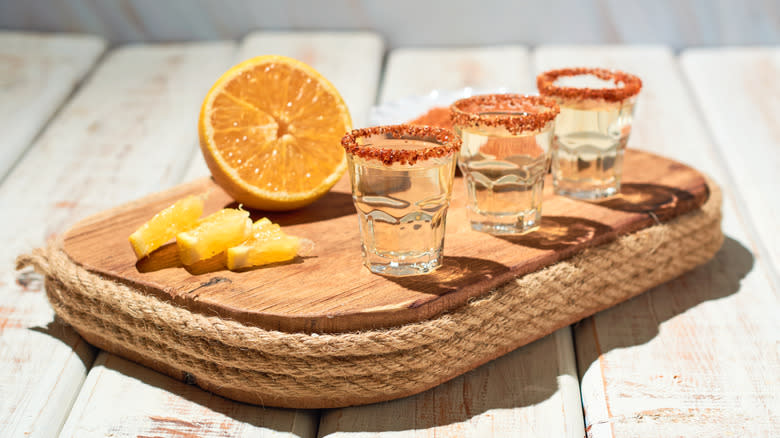
Tequila may be the original spirit in a paloma, but it isn't your only choice. If you're hoping to bring a different type of complexity to your drink, reach for another agave-based spirit: mezcal. This spirit's unique, smoky flavor comes from the cooking process, as the agave is roasted in underground pits before distillation. Of course, mezcal is not a monolith. There are 166 agave varieties that can be used to make mezcal and, just like grapes and wine, the variety, terroir, and production process will influence how the final product tastes.
Since we're talking palomas, look for a mezcal that will play nicely with grapefruit. "I like to pick more floral, delicate expressions of Mezcal as they can really augment the flavor," says Death & Co. bartender Matthew Belanger. In particular, he reaches for Del Maguey's Santo Domingo Albarradas blend, an Espadin mezcal with notes of tropical fruit and rose water. Espadin is the most commonly used agave varietal in mezcal production and has a high sugar content that produces a sweeter mezcal that's great for cocktails — and newbies.
Guerilla Tacos' Adolfo Valdez, meanwhile, likes to use La Luna Mezcal Cupreata. This mezcal, made with the cupreata variety, is floral and citrusy with soft smoke. Valdez likes that it enhances other ingredients without losing its own flavor. "It adds a nice earthy profile to the drink without being overpowering," he explains.
Go Classic With Squirt Or Jarritos
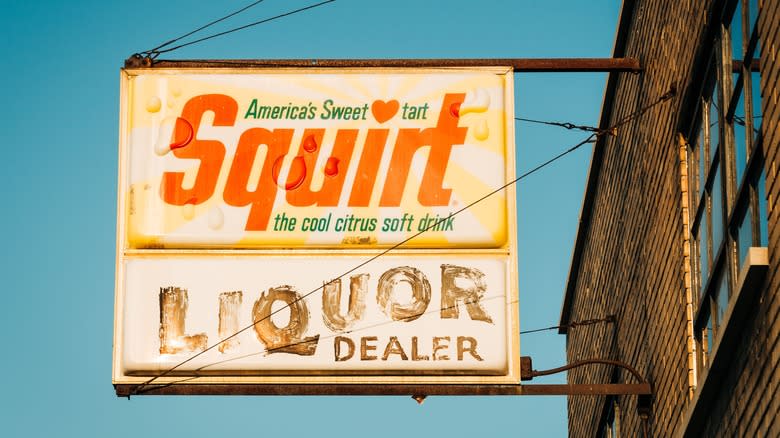
Two sodas are at the top of the list when it comes to choosing the grapefruit element of your paloma: Squirt and grapefruit-flavored Jarritos. Squirt emerged first, hitting shelves in 1938 and arriving in Mexico during the 1950s. Jarritos, meanwhile, was first sold in 1950, beginning with coffee (really!) and tamarind flavors, before making its way to the U.S. in 1988.
Squirt's arrival in Mexico coincided with the first appearance of the paloma cocktail, and the two are closely intertwined. After all, what could be easier (or more delicious) than pairing some tequila with a refreshing, citrusy soda? In fact, Squirt was advertising its use as a mixer for tequila by 1950, and the Paloma really could not have come to be without the invention of Squirt.
Then again, while Squirt was the original grapefruit soda in palomas as we know them today, Jarritos has held on to a lot of popularity due to its simple ingredients. Toro bartender Eric Garcia told us his restaurant uses Jarritos since it doesn't contain "high fructose corn syrup, plus it has a better natural taste of grapefruit." Per the company website, Jarritos only uses natural sugars and is less carbonated than other sodas like Squirt, resulting in light effervescence instead of intense bubbles (think sparkling water versus club soda).
Don't Shy Away From The Standard Recipe
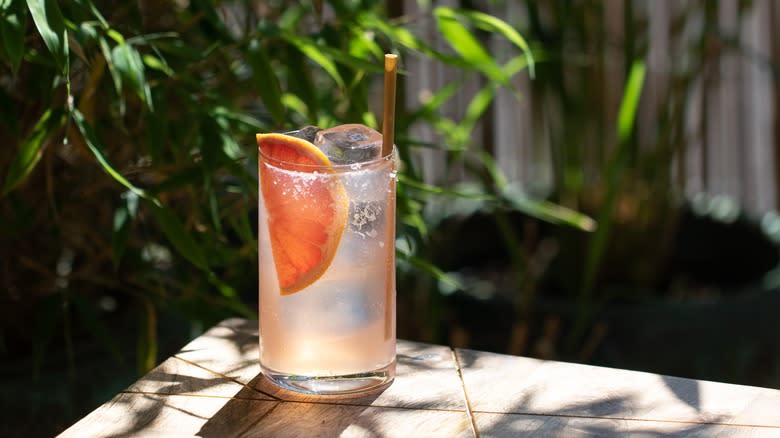
A great cocktail is all about balance: sweet, sour, and with just the right amount of alcohol. While the combination of tequila and grapefruit soda (Squirt and Jarritos are top contenders) is delicious and refreshing, it doesn't take much more to elevate your paloma to the next level. Try our classic paloma recipe, which uses grapefruit juice, soda water, and agave syrup in place of canned soda. "If I've got tools, simple syrup, fresh juice in my vicinity, I'll do something like [this]," says Matthew Belanger of Death & Co.
Making your paloma from scratch means you can customize the citrus, sweetness, and bitter notes to suit your taste. Be sure to use blanco tequila, which works best because it often features notes of citrus and tropical fruit. Since it isn't aged as long as other tequila varieties, its cleaner flavor profile won't overpower the grapefruit. And don't forget to salt the rim. Why? Salt enhances sweetness and softens bitterness -- which will help the grapefruit flavor in your paloma shine.
To make our go-to paloma recipe, rub a lime around the rim of your glass, then dip the glass in a dish of salt. Measure in 1 ½ ounces of tequila, 2 ounces of grapefruit juice, 1 ounce of lime juice, and ½ ounce of agave syrup. Stir well to combine, then add ice. Top your drink with soda water, give it one more gentle stir, and garnish with a lime wedge.
Experiment With Different Grapefruit Soda Options
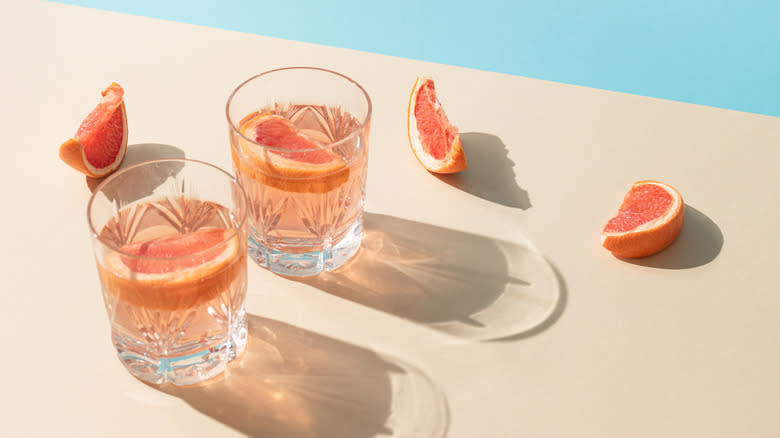
Squirt and Jarritos may be the most popular sodas used in palomas, but they aren't your only choices. There's a bevy of other grapefruit sodas to use in palomas that deliver that refreshing, citrusy taste. If you're interested in a more artisanal grapefruit soda, Adolfo Valdez recommends trying East Imperial Grapefruit Soda. "It adds body to any paloma, with floral hints, a nice fizz, and a dry finish," he told Tasting Table. The soda, made in New Zealand, has a slightly peppery flavor that brings out the grapefruit's floral, bitter notes.
For a sweeter option, choose Fresca, which has a more subtle grapefruit flavor than Squirt. Or if you'd rather have a very mild grapefruit flavor and no sugar at all, reach for grapefruit LaCroix for a drink that's lighter all around. Looking for more options in the soda aisle? Look for Fever Tree, Strongwater, Izze, or -- if you can find it -- Ting, a Jamaican soda that can occasionally be spotted in the U.S.You can also go the DIY route. At Death & Co., the house paloma recipe uses 1 ½ ounces of fresh grapefruit juice, ¾ ounce of fresh lime juice, ½ ounce of simple syrup, and 2 ounces of sparkling water in place of a bottled, flavored soda. Grapefruit is both sour and bitter, and using fresh squeezed juice brings enough bitterness to your drink to mellow the sweetness and let the flavor of the grapefruit -- and the tequila -- really shine.
Squeeze Your Own Grapefruit Juice
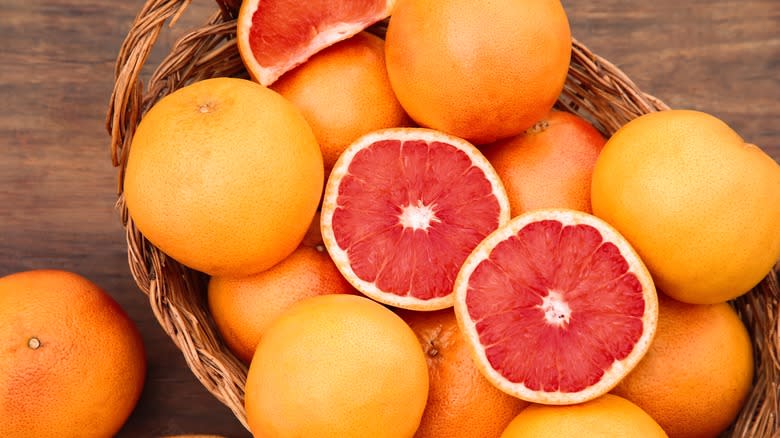
We all know fresh citrus juice makes a better cocktail, but why? Well, the citric acid in lemon, lime, and grapefruit juices is sharp enough to go up against — and mellow out — the astringent nature of unaged alcohol like blanco tequila. Unlike bottled citrus juice, which has additives to try to maintain the juice's vibrant flavor and acidity, fresh citrus juice is punchy and bright.
In a paloma, you also want the flavor and aroma of the grapefruit to be prominent. While soda is the go-to source of grapefruit flavor in a paloma, fresh grapefruit juice takes this classic cocktail to a different place. Toro bartender Eric Garcia agrees, noting that a paloma made with fresh grapefruit juice provides a better drinking experience. Plus, he adds "[I]t's not slapped with preservatives and extra refined sugars."
If you're squeezing fresh grapefruit for your paloma, opt to squeeze it right before you're mixing your drinks instead of batching it too far in advance. A day or two ahead is okay, but keep in mind that leaving citrus in the fridge for too long can result in a juice that has lost its potency. Since grapefruits are significantly bigger than lemons and limes, grab an electric juicer to make quick work of those huge citrus fruits.
Find Balance In Your Flavors
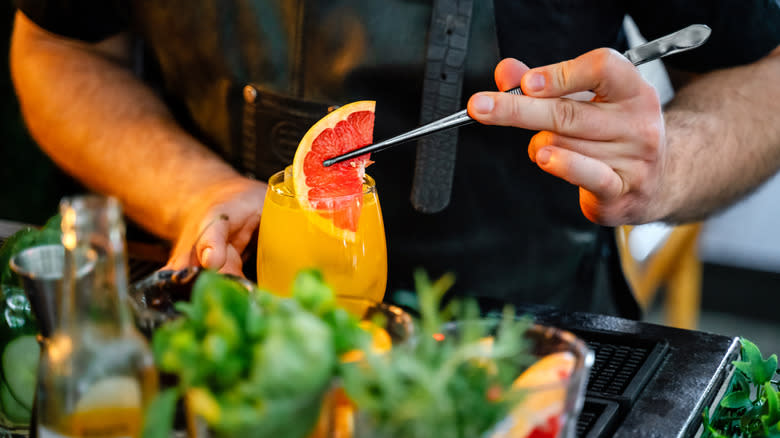
Palomas are deceptively simple. Yes, you can mix one up quickly by combining tequila with grapefruit soda. But within that simplicity is the opportunity to achieve cocktail nirvana -- AKA balance. Grapefruit is sweet and sour, while tequila can taste grassy or floral alongside the burning or astringent sensation that comes from unaged alcohol. These flavors are prominent and need to keep one another in check for a truly enjoyable drinking experience.
"Balancing a paloma is really about understanding your own palate and where your ingredients are at in season," said Matthew Belanger. "If the grapefruits are particularly bitter or tart I might swap a rich syrup in for simple syrup." A rich simple syrup is one with a higher concentration of sugar. Typical simple syrup is made with a 1:1 ratio of sugar to water, while rich syrup has a 2:1 ratio for more sweetness by volume — ideal for balancing an especially tart grapefruit taste. Belanger also incorporates a bit of salt (whether it's in the glass or on the rim) as this helps to mellow any bitterness while bringing out sweetness.
Add Some Heat

Just like tequila is an iconic Mexican spirit, chili peppers are an ingredient that helps define Mexican cuisine. In fact, chili peppers were one of the first plants to be domesticated in Mexico, and have been part of the country's food culture for thousands of years. It's no surprise, then, that tequila and chilis are a match made in cocktail heaven -- especially when it comes to palomas.
At Toro in Denver, Eric Garcia adds St-Germain and Serrano pepper to his palomas. "These ingredients just add a little bit more complexity to the beverage, adding more layers to what the traditional paloma holds," he tells us. While the drink is usually citrus-forward, the floral notes and spice make each sip a bit more exciting.
Meanwhile, Matthew Belanger turns to chile-infused tequila for spice, adding, "Depending on the heat, I might increase the sugar to compensate." Some producers make spicy tequila, but it's worth making your own chile-infused tequila so you can finesse the heat level and flavor profile to your liking. Chop up the chilis, add them to tequila, and come back in an hour or so. By then, your spirit should be ready to use. When making your paloma with a spicier tequila, it's a good idea to use a sweeter grapefruit soda like Fresca to balance the heat. Then, opt for a one-two-three punch of spice, salt, and sour with a Tajin rim. The salt and dried lime juice in the seasoning will help amp up the citrus flavor, giving the drink a nice, balanced profile.
Go Beyond Grapefruit

For a drink that only exists because of the invention of grapefruit-flavored soda, it's hard to imagine a paloma tasting like anything else. After all, if you eliminate the grapefruit entirely, you're really just making a tequila highball with the flavor of your choice.If you don't have fresh grapefruit juice and instead are relying on soda for your grapefruit flavor, Adolfo Valdez suggests adding Campari to increase the bitterness of your drink. Campari is an Italian aperitif that includes ingredients like orange and rhubarb, with herbaceous and citrusy notes that mimic the flavor of fresh grapefruit.
But that doesn't mean you can't add other flavors to the grapefruit base to make something a little more unique for your next summer get-together. With two things you probably already have — orange juice and salt — your paloma can become a cantarito. This tart Mexican cocktail is named after the clay vessels used to transport water in the Jalisco region (similar to the jugs for aguas frescas that gave Jarritos soda its name). For best results, use reposado tequila in your recipe (rather than blanco tequila, which is typically used in a paloma), as it will bring a greater depth of flavor to the drink due to its time in a barrel. The rim gets coated with Chamoy or Tajin for a spicy kick.
For a refreshing poolside sipper, sweeten your paloma with watermelon. Do this by throwing some of the chopped fruit into a blender and straining to remove the pulp and seeds. Stir it stir it into your cocktail to really bring home the agua fresca experience.
Mix Up Your Spirits
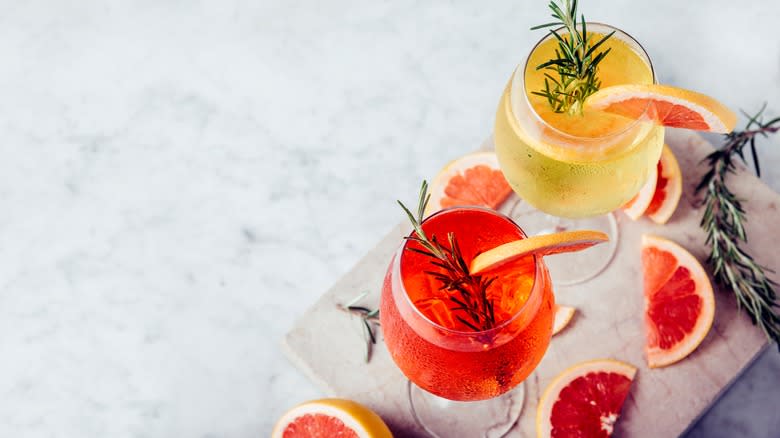
Want to transform your paloma from a simple highball into something a little more sophisticated? Think beyond tequila as the sole spirit and you can turn this light, refreshing drink into something even more quaffable: a spritz. At Death & Co., Matthew Belanger swaps the Paloma's usual grapefruit soda for a few ounces of pet-nat to turn it into a wine-based spritz. "We use a sauvignon blanc pet-nat from Orbis Moderandi that's super zesty and already tastes like grapefruit on its own, but I think a variety of wines would work well here," he reveals. A dry and fruity prosecco, refreshing cava, or a zippy sparkling chenin would all be great alternatives. Salt the rim of a Collins glass, then combine 3 ounces of pet-nat with 1 ounce of sparkling water. In a tin, shake together 1 ¼ ounces mezcal, ¼ ounce aperitivo (try Cappelletti, Aperol, or Campari), ¾ ounce grapefruit juice, ½ ounce lime juice, ½ ounce simple syrup, and 1 dash Angostura bitters. Strain into the Collins glass, add ice, and garnish with a grapefruit slice.
If you prefer bourbon to tequila or mezcal, you're in luck: Bourbon is a great match for grapefruit. A Brown Derby cocktail pairs bourbon with grapefruit juice and honey for an elevated option with Hollywood history. Don't want to get out your shaker? Keep in the spirit of a paloma by topping bourbon with grapefruit soda for a refreshing drink that highlight's the whiskey's spice notes.
Read the original article on Tasting Table


